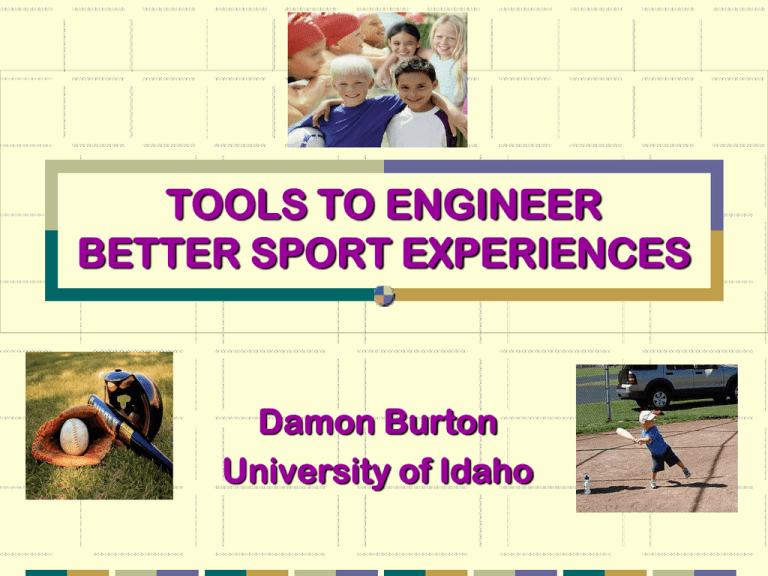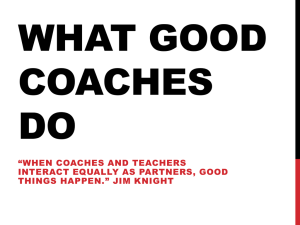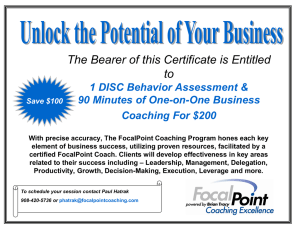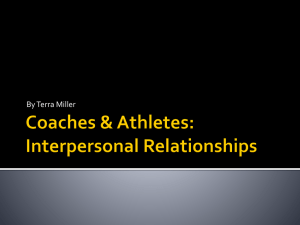UNDERSTANDING AND OPTIMIZING COMPETITION
advertisement

TOOLS TO ENGINEER BETTER SPORT EXPERIENCES Damon Burton University of Idaho TALE OF 2 TOPICS Measuring Coaching Effectiveness Coaching Success Questionnaire -2 (CSQ-2) research tool and coach development tool. Competitive Engineering to create positive motivational climates, promote prosocial development, and make sport fun. WHAT DO WE KNOW ABOUT COACHING EVALUATION? 1989 Coaching America’s Coaches Conference talk Minimal systematic coach evaluation occurs at high school or collegiate levels. Evaluation typically based on won/loss record to hire and fire minimal use for coach development ORIGINAL COACHING SUCCESS QUESTIONNAIRE CSQ developed for 1992 study for American Coaching Effectiveness Program (ACEP) . . . comparing coaching success of teacher- vs ACEP-trained coaches examining sources of coaching competence Needed an objective measure of coaching success besides winning. 67 items, 15 subscales, & 5 dimensions (e.g., winning, enjoyment, and physical, social & psychological development ). MEASURING COACHING EFFECTIVENESS Cote & Gilbert (2009) developed an integrated coaching effectiveness model. Knowledge • professional • applied • • Athletes’ Outcomes Sport Context sport skills teamwork * level * sport type MEASURING COACHING EFFECTIVENESS Mallett & Cote (2009) developed the Coaching Behavior Scale for Sport to assess applied coach knowledge. Athlete outcomes provide a more direct measure of coaching effectiveness. The Coaching Success Questionnaire-2 designed to measure athlete outcomes as a direct measure of coach effectiveness. DEVELOPMENT OF CSQ-2 Conceptual foundations, Assessment model, and Stages of instrument development. CONCEPTUAL FOUNDATIONS Congruent with Cote & Gilbert’s (2009) coaching effectiveness model for measuring athlete outcomes, Designed to assess coaches’ development of athlete’ intrinsic motivation (Ryan & Deci, 2000), Based on coaches’ development of athlete resilience (Dweck, 1999). ASSESSMENT MODEL hypothesized 5 dimensions and 18 subscales, confirmed 5 dimensions & 10 subscales, Some subscales focused on coach behaviors that athletes did not readily recognize, Motivation & communication subscales were not confirmed due to high correlations with most other subscales. CSQ-2 DEVELOPMENT Stage 1 – CSQ developed in 1992, 67 items , 5 dimensions and 15 subscales, Stage 2 – CSQ-2 developed as Andy Gillham’s dissertation, CSQ-2 Form A – 99 items, 5 dimensions & 18 subscales, CSQ-2 Form B – 76 items, 5 dimensions & 12 subscales, and CSQ-2 Form C – 40 items, 5 dimensions & 10 subscales. “Final Form” was confirmed. CSQ-2 DIMENSIONS AND SUBSCALES Winning Attitudes about Winning, Winning, Enjoyment, Physical Development Physical Conditioning, Skills & Strategies, Wellness. CSQ-2 DIMENSIONS & SUBSCALES Psychological Development Self-Confidence, Emotional Control. Social Development Teamwork, Sportsmanship. CSQ-2 USE 1: RESEARCH TOOL Identify relationships between coach effectiveness and key antecedent and consequent variables such as . . . Coach background and training variables (e.g., teacher training). Team variables (e.g., motivational climate), Athlete resiliency and self-esteem. Dependent measure to assess coaching education effectiveness. CSQ-2 USE 2: COACH DEVELOPMENT TOOL Minimal systematic coach evaluation and development at any level, Existing won/loss record evaluation used primarily to hire and fire coaches, Because of limited nature of coaching education in U.S., evaluation can be a valuable tool for creating motivation for coach development. 5 STEPS TO MAKING COACH DEVELOPMENT WORK Step 1 -- Use CSQ-2 to assess coaches’ strengths and weaknesses, Step 2 -- After the season, the Athletic Director would use CSQ-2 data to identify 2-3 key areas for professional growth. Step 3 -- The AD and coach would agree on specific goals to work on for each growth area. 5 STEPS TO MAKING COACH DEVELOPMENT WORK Step 4 -- Coaches would be provided with resources to enhance their knowledge. Coaches might read the communication chapter in Sport Psychology for Coaches. Coaching development guided using a workbook of exercises. Step 5 -- Learning communities may be developed where a group of coaches meet regularly to work collaboratively on growth areas (see Gilbert, Gallimore & Trudel, 2009). ROLE OF CSQ-2 IN COACH DEVELOPMENT It measures athlete outcomes, the most direct measure of coaching effectiveness. It’s a psychometrically-sound instrument that is quick for athletes to complete. It’s easy to score and interpret results. Supplemental materials can readily be developed to facilitate coach development. The CSQ-2 is a tool that facilitates systematic coaching education and development. COMPETITIVE ENGINEERING The competitive engineering process in youth sports … modifies the structure, rules, facilities, and equipment of a particular sport to enhance athletes’ competitive experience. benefits include enhanced skill development, enjoyment, & attitudes toward physical activity while reducing attrition. has been used extensively, but in a haphazard fashion, with no model to guide implementation. MOTIVATIONAL CLIMATE CONCEPTUAL MODEL Competitive engineering is a motivational climate strategy that attempts to enhance motivation through systematic change in the competitive environment. Motivational climate has its origins in achievement goal theory that has found players in mastery-oriented (i.e., process) climates have higher intrinsic motivation, greater enjoyment and satisfaction and less attrition than do outcome-oriented (i.e., product) teammates. STRUCTURING A BETTER MOTIVATIONAL CLIMATE CE attempts to enhance intrinsic motivation by creating positive changes in how youth sport is structured to enhance competence, increase personal selfdetermination or autonomy, and provide greater opportunities to be with friends (i.e., relatedness). MASTERY CLIMATE CORRELATES Cote et al.’s (2008) Developmental Model of Sport Participation suggests the “sampling years” between 6-12 is a time to emphasize “deliberate play” that maximizes enjoyment for both future recreational and elite performers. Mastery climate also promotes prosocial development (First Tee, 2006; Petitpas et al., 2005). COACHING EDUCATION VERSUS COMPETITIVE ENGINEERING Youth coaches don’t like to invest time in coaching education. Coaching is considered a short-term activity but improvement takes time and focus, Problem coaches don’t typically participate in coaching education programs. Competitive engineering only has to convince administrators to adopt CE modifications. Structural modifications create the opportunity for positive change. Existing research supports the value of competitive engineering. WORKING COMPETITIVE ENGINEERING MODEL 6 goals, 4 strategies, 4 techniques. COMPETITIVE ENGINEERING OVERALL GOAL Competitive engineering attempts to create programs that ensure consistent physical, psychological and social development is emphasized more than winning. However, when development is maximized, the chances of winning also increase. COMPETITIVE ENGINEERING GOALS attract athletes to sport, increase process orientation and intrinsic motivation, enhance skill development, increase perceived competence, maximize fun and enjoyment, and minimize burnout and attrition. TAKING A HINT FROM SANDLOT GAMES … Coakley’s (1980) research In sandlot games, kids modify games, maximizing enjoyment and keeping everyone involved so the game continues. “Sandlot” games typically result in increased cooperation, decision making, creativity, and action…things stifled in rulecentered organized sport . CE STRATEGIES: WHAT ATHLETES WANT increase action and scoring, create high personal involvement, keep scores close, maintain positive social relationships with teammates and opponents (Coakley, 1980). COMPETITIVE ENGINEERING TECHNIQUES modify rules, change facilities, adjust equipment, provide choices of competitive level. CE TECHNIQUE EXAMPLES CE STRATEGY & TECHNIQUE EXAMPLES 1. increase action and scoring “kid-size” equipment & facilities and modify rules to advantage the offense 2. create high levels of personal involvement increase playing time and opportunities to play “glamour” positions 3. keep scores close equalize talent across teams and have “catch-up” rules 4. promote positive relationships between all participants utilize joint practices, socialization rules, and social events PYRAMID MODEL OF SPORT PROGRAMMING Level 5: Regional Travel Team Level 4: Local Travel Team Level 3: Competitive Leagues Level 2: Recreational Program Level 1: Instructional Program FLAG FOOTBALL CE STUDY Conceptual Focus 1. Increase action and scoring, Enhance personal investment, Decrease excessive physical contact. Research Protocol 2. “Kid-size” football and field “Delayed rush” rule to prevent defensive line from crossing line-of-scrimmage for 3 seconds Results 3. Total points increased by 115%, Percentage of kids scoring increased by 50%, Enjoyment increased extensively, and Attrition was reduced 22% the following season. FUTURE RESEARCH QUESTIONS Is more CE better? 1. 2. Number of modifications overall, Number of modifications for each CE technique. Does the type of modification impact effectiveness? Which strategy modifications are most effective (e.g., close scores versus increased scoring)? Even within the same strategy category, which modifications have greater impact on athlete outcomes (e.g., position played versus playing time)? What implementation protocol (i.e., rationale) will best sell CE to administrators, coaches, & athletes? What implementation protocol will maximize athlete outcomes (e.g., explaining rationale and teaching implementation strategies)? WANT MORE INFO? Powerpoint loaded on handout system, Email to dburton@uidaho.edu, Manuscripts will be loaded on our Practitioner Website when accepted for publication. THE END






